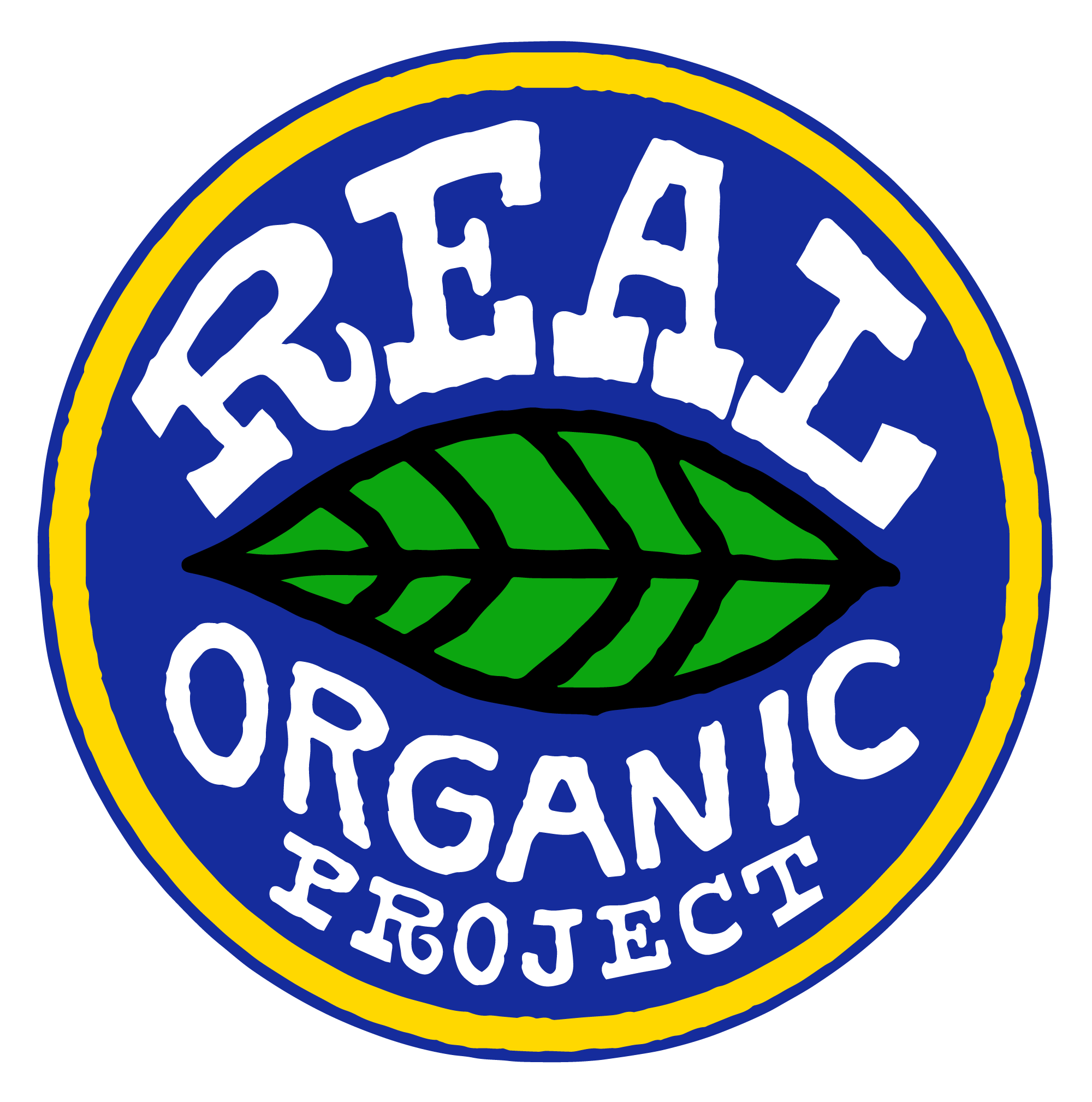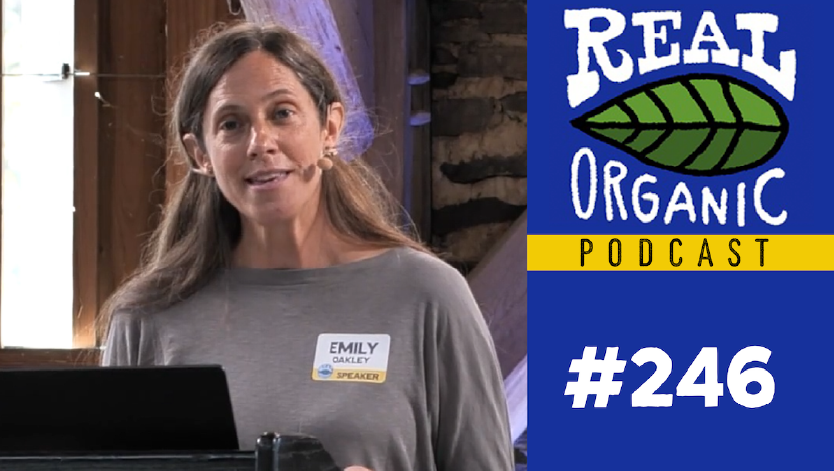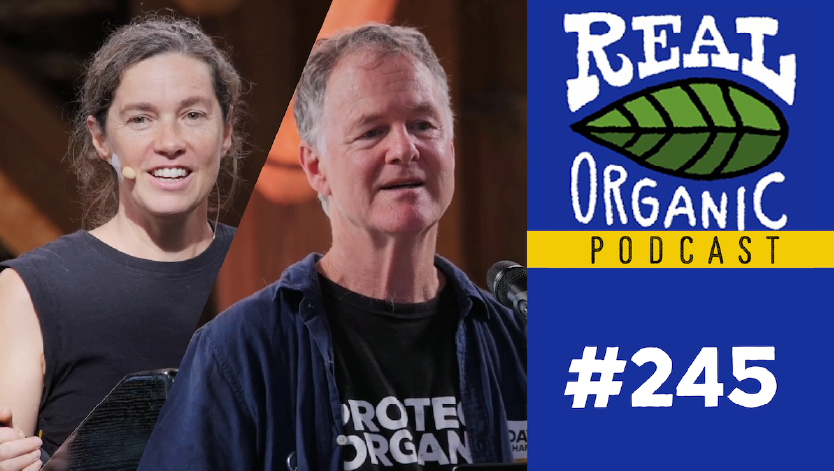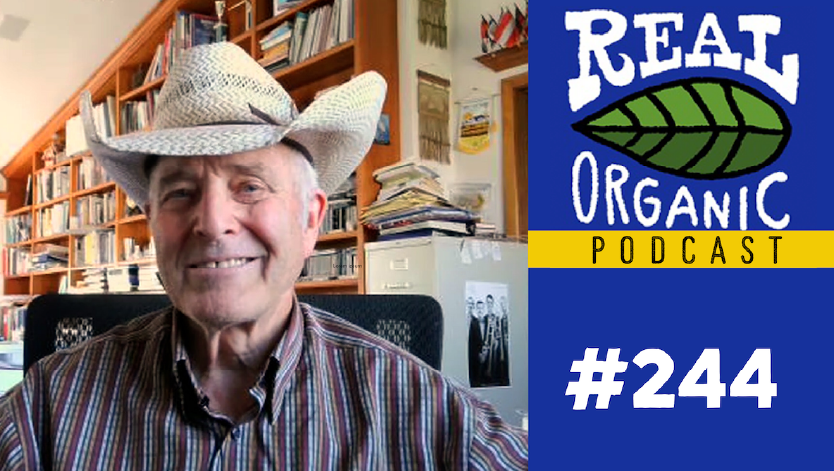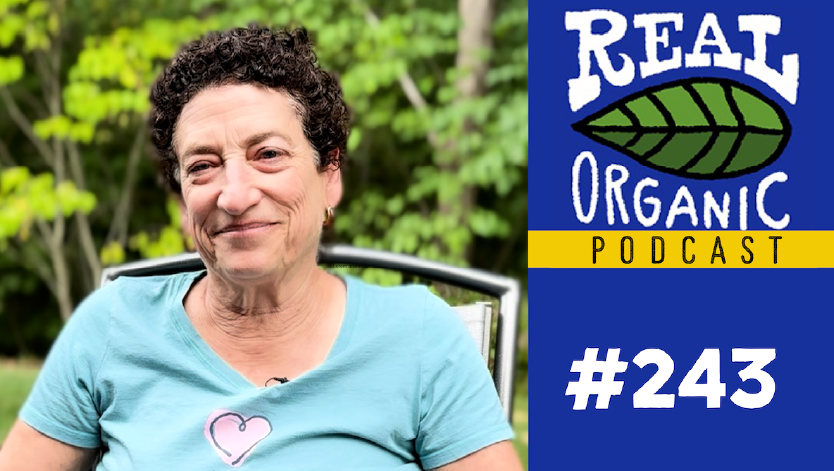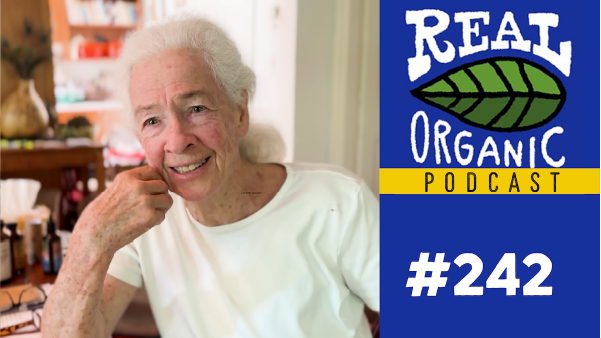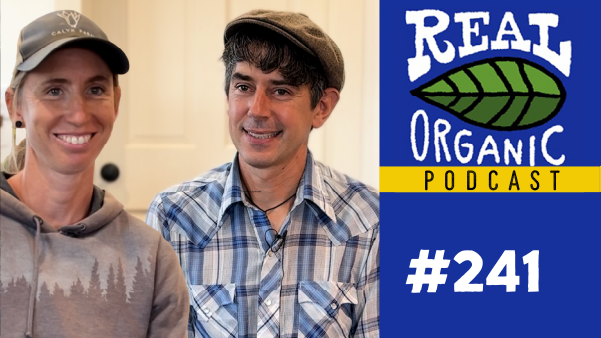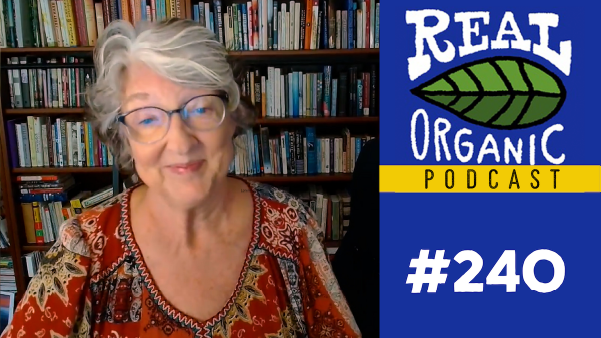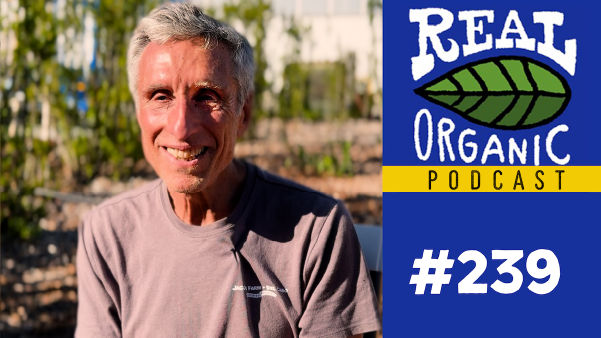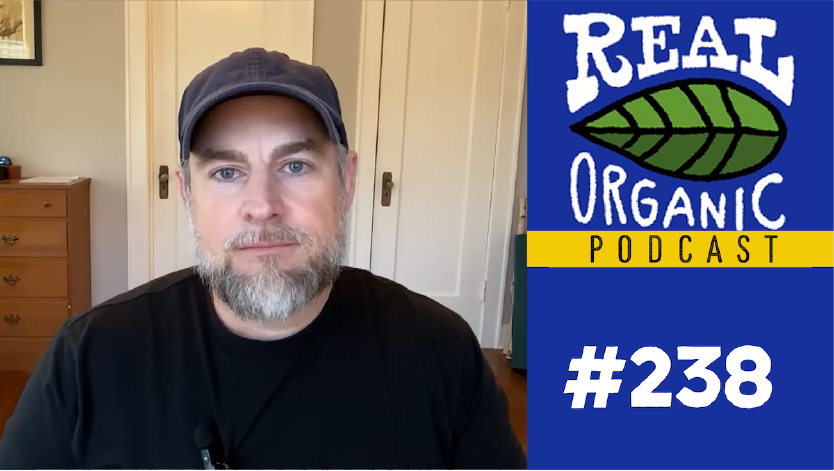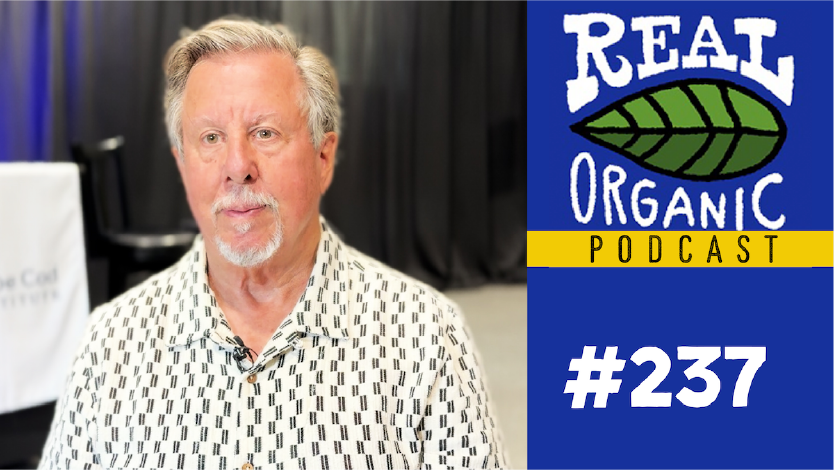Episode #232
Eli Pipkin: Mastering Whole Grain Bread
At Stone Barns, bread is more than a side dish – it’s a statement. Eli Pipkin, the head baker behind the celebrated whole grain bread program at Blue Hill, joins us to talk about how he sources, mills, and bakes grain in ways that connect back to farmers and the soil. In this conversation, Eli explains the unique challenges of working with freshly milled flour and how his team is rewriting the rules of bread-making by letting flavor, nutrition, and land stewardship guide the process. If you care about real food, you’ll want to hear what Eli has to say about whole grain bread.
Our Eli Pipkin interview has been edited and condensed for clarity:
You can subscribe and download episodes of our show through your favorite podcast app, our YouTube channel, or stream the audio-only version here:
Dave Chapman interviews Eli Pipkin at Stone Barns in Tarrytown, NY, June 1, 2025:
Dave Chapman 0:00
Welcome to the Real Organic Podcast. I’m talking to my friend Eli, who is the head baker at Blue Hill at Stone Barns. We didn’t record it, but Dan just reminded me that he thinks you’re the best baker.
Eli Pipkin 0:20
Again, too kind.
Dave Chapman 0:22
I understand. Let’s just say you’re a really fine baker. You make incredibly good bread. Your whole wheat bialys are amazing. He also said, “Don’t let Eli tell you how easy it is because it isn’t.”
Eli Pipkin 0:44
Funny.
Dave Chapman 0:44
All right. Let’s just start talking about bread and go from there.
Eli Pipkin 0:48
Happy, yeah.
Dave Chapman 0:50
I’ve been in when you were baking, and you showed me your living dough. Is the dough alive?
Eli Pipkin 0:59
Absolutely. Doughs in general, yeah. Fermentation is a living thing. I think you could even say, in a sense, our dough is more alive because the flour we use is alive. It’s all whole grain, freshly milled, with nothing sifted out. When you’re sifting flour, you’re removing the life-giving components – both for yourself and for the grain. That’s why white flour lasts forever. So, in a variety of ways, our dough is very much alive.
Dave Chapman 1:28
White flour lasts forever because they’ve taken out the bran and the germ.
Eli Pipkin 1:31
Bran and germ – the things that can go rancid after a period of time. It’s not like you can’t use it within a few days. This is why we got into roller milling, and why white flour became so popular. That’s a longer story, though. We’ve been sifting forever. I think people have, for a long time, felt somehow that white flour is superior – maybe texturally, I don’t know. To me, it doesn’t really make sense.
Dave Chapman 2:00
White flour bread is delicious, but…
Eli Pipkin 2:39
Of course, that’s how I started.
Eli Pipkin 1:27
…but whole wheat bread is super delicious.
Eli Pipkin 1:27
It’s different. I also don’t want to sit here and say that one is inherently better than the other. I want to be clear – bread is bread. You can be very intellectual about it and put it on this very high place, which I think I do, but it’s also the most basic of foods. It may be counterintuitive to say, but I think there’s nothing wrong with white bread. White bread is delicious.
Dave Chapman 1:27
Do you think that part of what made bread such a staple was that you could harvest the wheat and store it for a long time until you milled it? You had a reliable source of nutrition through the long winter.
Eli Pipkin 1:27
Exactly.
Dave Chapman 1:27
What happened?
Eli Pipkin 2:49
That’s a complicated question. I think it’s a lot of things. I think, obviously, roller milling started in the mid-1800s, I believe.
Dave Chapman 3:04
What is roller milling?
Eli Pipkin 3:05
Roller milling is a kind of milling that is designed to separate the endosperm – which is what we all know as white flour – from the bran and the germ, which make whole grain flour, whole grain flour. All of a sudden, we had a shelf-stable ingredient. Then I also think…
Dave Chapman 3:22
You could ship white flour all across the country. It had already been milled. You could put it in bags, you could put it on the shelf…
Eli Pipkin 3:30
Label it “bread flour” and rip it open.
Dave Chapman 3:33
…and it doesn’t go bad.
Eli Pipkin 3:34
Exactly. It’s also incredibly functional. It’s funny to me because, again, I started in a white flour bakery. It’s almost like – this could be a generalization – but some bakers don’t want to have to think about the flour piece of the workflow because baking requires a lot to manage. It requires a lot of multitasking. If you’re baking whole grain, you’re having to think about the flour, especially if you’re milling it, which is a whole other piece of it.
Eli Pipkin 4:03
All of a sudden, we had a stable white flour. Then I think it was also post–World War Two – just like mass production, easy food. We just leaned into that style of eating in a variety of ways. So, we got totally lost in terms of our relationship with bread.
Dave Chapman 4:22
Tell me about the bread that you make.
Eli Pipkin 4:27
It’s funny because I wasn’t always planning to be a baker. I thought I was going to work in government. I got into baking at home. To me, it’s funny – it’s almost serendipitous. I look back, as I was baking at home, Jonathan Bethony of Seylou in Washington, DC was opening, and I was super into the Chad Robertson Tartine bread – high hydration, open crumb. I thought that was the pinnacle.
Eli Pipkin 4:51
Then I heard about this guy who’s opening a mill and a bakery. I couldn’t grasp, at the time, how profound that is – what Jonathan did. Then I went and tried his bread. I ripped it open and smelled it. I had never smelled anything like that. I think, like a lot of people, the first time they try whole grain bread, it’s like a shock to the system almost because it is so aromatic. It is so flavorful.
Dave Chapman 5:21
We source grain from local farms. We have a New American Stone Mill on site. We mill all of the grain ourselves – that’s all kept whole – and then it’s fermented naturally, through the sourdough process, so you have long fermentation, sort of a pre-digestion.
Dave Chapman 5:36
Okay, it’s all good. Let’s talk about making the bread. You mill the flour.
Eli Pipkin 5:45
Yeah, every day. That’s a big part of the process. The mill is the heart of the bakery, absolutely.
Dave Chapman 5:54
Just to say, one can get a small, mighty mill at home.
Eli Pipkin 5:58
Exactly, the Mockmills are great.
Dave Chapman 6:00
I do that, so it’s not like, “Oh, I can’t do that.”
Eli Pipkin 6:04
Also, it’s a great way to get other grains in your breads, too. Like, if you want to start experimenting with millet, sorghum, buckwheat, and barley – all these things that, often, the farmers we work with will grow, because usually they’re practicing crop rotation.
Eli Pipkin 6:22
I’ll never forget – going back to Jonathan – he told me this story. When he was opening Seylou in Maryland, he approached – now I remember, I was talking about Next Step Produce earlier – he approached Heinz, who’s a great farmer in Maryland, and said, “Okay, how much wheat can you grow me?”
Eli Pipkin 6:29
Heinz responded, “I’ll grow you this amount, but if I do that, you’re going to have to buy my buckwheat, sorghum, millet, or legumes,” all these things that he’s growing that, sometimes – at least on the baking side – there’s not a market for. That’s a huge piece of what we do as well. So, anyways, Mockmills are great for that stuff, as well.
Eli Pipkin 6:45
Also, I think it’s a cool way to just – if you get a Mockmill, which are pretty affordable – it doesn’t mean you have to become a whole grain baker all of a sudden, but you can start experimenting with cool things like spelt or rye in small proportions that’ll definitely change the flavor profile of your bread.
Dave Chapman 6:49
Just mix a little in.
Eli Pipkin 6:55
Totally. Then, all of a sudden, you’re hooked. It’s hard to go back once you start experiencing that, which – it’s a deeper connection to the process.
Dave Chapman 7:14
Okay. You’ve milled your flour, and maybe from different grains: a little spelt, some rye, a little wheat…
Eli Pipkin 7:24
The wheat is a huge category.
Dave Chapman 7:24
A lot of different wheats.
Eli Pipkin 7:24
A lot of different wheats, yeah.
Dave Chapman 7:29
Could you just talk a little bit about it? Because it’s confusing. You go to the store, and you see white spring, hard winter, soft – I don’t know.
Eli Pipkin 7:36
Even seeing “white” on a whole wheat bag of flour, it’s like, “Wait, that doesn’t make sense.” But generally, it’s red and white, so just the color. Then winter or spring, which is the season or when it’s planted. Then, hard or soft – is it high protein or low protein? But I also think those classifications people really lean into, but within them, there’s a lot of fluctuation.
Eli Pipkin 8:03
To me, farming organically is one of the hardest things you can do. I think growing wheat that way is mind-boggling to me. I don’t know the process. I know it’s incredibly complicated, and so the byproduct of that – the grain we use – is changing all the time. Even a hard red spring wheat may come with this high protein percentage and all this stuff, but those metrics only go so far.
Eli Pipkin 8:27
Once you start working with it, that’s when you really get to know its functionality and flavor. Nothing – just because it’s on the label – doesn’t mean that it’s going to act that way, if that makes sense.
Dave Chapman 8:36
There’s a level of uncertainty as you get to know the different grains and the flour that they make. They taste, behave, and rise differently, and they have different textures.
Eli Pipkin 8:50
Totally. The beauty is just like finding the grains that you like to use, finding the farmer that you like to work with, and then bringing his or her grain in and putting it together in pieces to get what you think will be the end product, and that’s changing all the time. A lot, season to season, and also day to day as well.
Eli Pipkin 9:36
Have you seen Marto?
Dave Chapman 9:38
Yeah. He’s going to be at Joan Gussow event. He’s speaking at it. That’s wonderful. I get to eat very well.
Eli Pipkin 9:46
That’s amazing.
Dave Chapman 9:47
I go around, and people give me the best foods.
Eli Pipkin 9:47
I love it. That’s why I fell in love with baking. It’s the act of giving someone something that you created. That’s why all these cooks work so hard. That’s why it’s very special.
Dave Chapman 10:02
I watched that TV show “The Bear.” All the chefs must have watched “The Bear.” But this second or third season, whatever they’re describing, when the guy is learning about service, his cousin goes to a top-end place. The first time I got it, I knew I had been served. But I didn’t have words for it. I’m like, “Oh, this is what they’re doing.” How do I create this experience? Not just, how do I feed you, but how do I give you the experience of being cared for and being fed…
Eli Pipkin 10:40
Then just feeling out of use and not having to think about things, and all of a sudden, it’s beautiful because I also think that allows you to just really focus on what you’re eating and appreciate it.
Dave Chapman 10:49
It makes you actually pay attention. I had one guy I knew who had been a head waiter, and he said, “I got out of it because people were on their devices the whole time. I couldn’t take it.”
Dave Chapman 11:01
You’ve made flour and run it through the mill. You’ve got a mixture of different grains. You have a sourdough culture.
Eli Pipkin 11:01
Yes.
Dave Chapman 11:05
Let’s talk about that.
Eli Pipkin 11:17
Of course. To me, the most important first piece is the flour, and then the second most important piece is that culture, the levain sourdough. It’s just a mixture of flour and water. Into that mixture, wild yeast and bacteria just like to live there. Those microbes are in the air, on your hands, and even on the grain. Grain has everything it needs to turn into bread, which I think is funny.
Eli Pipkin 11:41
So, just flour and water, and then these microbes basically build a community there, and that’s what you use to leaven your bread.
Dave Chapman 11:50
Can we talk about how you care for your culture and how you maintain it?
Eli Pipkin 11:53
Super important. When I was a home baker, there was a book I read by Trevor Jay Wilson called “Open Crumb Mastery.” That was in my phase of…
Dave Chapman 11:54
Called “Open…”
Eli Pipkin 11:55
“Open Crumb Mastery.” That was when I was obsessed with getting this beautiful open crumb.
Dave Chapman 12:02
Open the crumb with the bread.
Eli Pipkin 12:03
Exactly. That can be a separate conversation. I think it’s less of a metric of good bread, but what he allowed me to realize is that caring for your starter is such an important piece of it. If you’re really serious – I was feeding, ‘feeding’ meaning refreshing – so, flour and water. It’s a little ecosystem. It runs out of food, and eventually it will die.
Eli Pipkin 12:29
When you feed, you refresh the levain. You’re taking a little bit of your active culture and just refreshing it – or adding new flour, new water, and basically restoring the food supply. That’s kind of how to think about it. I would do that twice a day.
Dave Chapman 12:43
Twice a day?
Eli Pipkin 12:44
Twice a day. We do it about three times a day.
Dave Chapman 12:47
Oh, wow. Tell me about that. I’ve never done that.
Eli Pipkin 12:50
Yeah. Our production here is we’ll feed it, refresh it in the morning, refresh it again around midday, and then refresh it again at night. So, you’re just trying to keep the culture healthy. Also, you always want to be cognizant of the amount of acidity a levain brings.
Eli Pipkin 13:07
If you let something ferment for 24 hours or more, it’s very acidic, which you can do purposely if you want, for a sharp rye bread or something like that, which we do. But usually, our master, or our mother levain, we like to keep… we call it young. So, fermentation is a bell curve, and we like to keep it on the up, if that makes sense.
Dave Chapman 13:29
Interesting. You’re feeding it about 50% flour and 50% water.
Eli Pipkin 13:36
Equal parts, usually. Sometimes we go a little stiffer, but I would say generally, 100% flour to 90% to 100% water.
Dave Chapman 13:45
Okay. Maybe a little drier.
Eli Pipkin 13:47
Exactly. Sometimes, yeah.
Dave Chapman 13:50
Of course, you’re not doing this on a home scale. If you’re on a home scale, how much flour would you use with the water?
Eli Pipkin 13:58
The way I would do it: I would use 100 grams of flour, 100 grams of water, and, if I know that it’s going to ferment overnight, 2 grams of levain, or the starter itself. Then, if you know that in the morning you want to refresh it but use it within four hours, you take a higher seed percentage.
Eli Pipkin 14:17
We call it “a seed.” That’s the piece you’re taking from the levain and refreshing. You can go with 100 grams flour, 100 grams water, and 50 grams levain. That’s going to move faster because there are more microbes coming with the pinch of starter.
Dave Chapman 14:32
So, if you knew at seven in the morning that, at noon, you wanted to make some bread, you would go heavier, bringing over more levain…
Eli Pipkin 14:39
Exactly. You can even go equal parts all the way, like one-to-one flour, water, and levain, if you really want it to move. Also, water temperature is important, too. Warmer water will encourage faster fermentation. Those are things that we all control in the bakery, depending on the workflow.
Dave Chapman 14:56
All right. Somebody’s job every day is to keep refreshing the starter?
Eli Pipkin 15:02
Exactly, yeah.
Dave Chapman 15:03
Eli, what happens if you don’t refresh the starter?
Eli Pipkin 15:07
I think people think that this is such a delicate ecosystem. I hear all the time, like, “Oh, my levain died. My starter died. I forgot about it.” This is so resilient. It can go days, I would even say maybe weeks without being fed. You can still, again, take a little bit of that seed, refresh it, and it will bounce back.
Dave Chapman 15:27
It’ll bounce back. That was my experience. But I didn’t know what I was doing, and I was just like, “God, I don’t know. I haven’t done this for days.”
Eli Pipkin 15:35
That’s also what was the hardest part as a home baker to grasp – reading your levain, which is really important. That’s part of the life that we’re talking about.
Dave Chapman 15:46
The more often that you refresh it, the impact on the bread will be what?
Eli Pipkin 15:52
Within reason, it’s not like this never-ending scale. Generally, the more you’re refreshing it, the more active the levain is, as we call it. I’ll call it almost like the fermentation is stronger. It’s a little bit quicker. I have images of myself when I was starting, waiting eight hours for my bread to be ready, just in that first phase of fermentation, which is called the bulk fermentation – just where the microbes are populating. Nothing has really happened yet; they’re just reproducing.
Eli Pipkin 16:22
In theory, in my head, the more you’re refreshing, the faster that levain will populate the dough that you’re making. Does that make sense?
Dave Chapman 16:31
Yeah, that does make sense. It’s got a bit more fresh life, and it’s ready to go?
Eli Pipkin 16:37
Yeah, exactly.
Dave Chapman 16:40
All right. So, you’ve got your milled flour and your sourdough starter. Tell me what happens next.
Eli Pipkin 16:51
There are so many ways to do this next part. It also depends on what you want to make. So, if you’re making a 100% rye bread, rye doesn’t really have functional gluten, so that’s going to be a very different process from just a classic, what I would call, a pain au levain, a classic sourdough. For a classic sourdough, generally, you have your milled flour, and your active levain. It depends on the day. You don’t have to do this.
Eli Pipkin 17:15
Usually, we autolyse, which is just mixing flour and water and letting that sit for, I would say, 25 minutes to an hour for a workflow day. But also, that autolyse can last a long period of time. You can do it overnight. When flour and water sit together, gluten starts to naturally develop, and enzymes start to break down the flour.
Eli Pipkin 17:34
So, in theory, the fermentation is done faster because the sugar is already free for the microbes to eat. It shortens mixing time if you’re using a machine mixer.
Dave Chapman 17:44
Did I just hear you say that the fermentation period – this kind of primary fermentation period – can be as short as 25 minutes or as long as overnight?
Eli Pipkin 17:57
Yeah. I wouldn’t necessarily classify it as a fermentation period. It’s just the flour is hydrating; the network is starting to form. You’re not going to get any life from that period. The main reason why we do it is because we want to shorten the mix time, because that’s something that you want to be wary of, especially with delicate doughs, like whole grain doughs.
Eli Pipkin 18:15
If you’re using a machine mixer, there’s a risk of overmixing, where you’re just developing the gluten… Again, there’s a sort of bell curve. You’re going, going, going, then you’ve gone too far, and you’ve destroyed the gluten matrix, and you can’t really bounce back from that, because it’s a muscle. It’ll tear if you’re working it too hard.
Dave Chapman 18:30
Okay. Is working by mixing or kneading?
Eli Pipkin 18:33
Yeah. Kneading and folding. Generally, I always trust my hands. I think it would be really hard to overmix a dough through folds because you have a better read of it. With the mixer, you’re just using your visuals. You’re not having your hand in the mixer, necessarily. If I’m worried that I’m close to overmixing or undermixing, I’ll just pull it and switch to my hands and just go by feel.
Dave Chapman 19:00
Overmixing ultimately, will destroy the texture and kill it.
Eli Pipkin 19:05
I call it “stringing out.” You can touch the dough, and it’ll just drag with you. You can’t handle it, and then it’s going to just collapse in the oven. It’s going to have no ability to hold itself up, because, obviously, as fermentation occurs, air bubbles start to form in the dough. The gluten is what captures that, but if you tear the gluten, it’s not going to be able to hold the air.
Dave Chapman 19:28
When you do that first mix, whether it’s for 25 minutes or overnight, you’ve added maybe half of the flour you’re going to add?
Eli Pipkin 19:41
All the flours in.
Dave Chapman 19:41
All the flours in?
Eli Pipkin 19:42
Yeah.
Dave Chapman 19:43
And all the waters in?
Eli Pipkin 19:44
This also depends. That again goes back to how you… It’s dough specific, I guess I’ll say. For our pain au levain, our classic sourdough, we autolyse equal parts flour and water – 100% flour and 100% water. If we’re talking about 1,000 grams of flour and 1,000 grams of water. We’ve hydrated the dough so there are no dry flour particles. We’ve let it rest for, say, 25 minutes to an hour, and then the autolyse period ends when you add your active levain and your salt.
Dave Chapman 20:17
In that first period, you haven’t added the sourdough?
Eli Pipkin 20:22
No. You can. I know that’s like “Tartine Bread’s” by Chad Robertson… he called it a fermentolyse. A true autolyse is just flour and water. No fermentation is really happening. It’s just the flour and water getting to know each other. Then that ends when the salt and the levain are added. Now you are kind of on a time clock because once the levain is added, you are thinking about the pace of the fermentation.
Dave Chapman 20:45
All right. This is news to me. This is interesting. And you add salt?
Eli Pipkin 20:50
Yes, it’s very important. You add salt for taste, and also to tighten the gluten a little bit because without salt, the gluten won’t really ever form to the point where it can hold itself up in the oven. It’s also to curb fermentation as well. If you just let flour, water, and levain sit, it’s going to outpace your ability to control it, if that makes sense. It’ll just move too fast for you to get enough development in, shape it well, or bake it well.
Dave Chapman 21:19
Tell me about development.
Eli Pipkin 21:21
That’s one of the keys. There are a lot of pieces. Development means you’re just… Again, gluten is a muscle. You’re working it, and as you start to develop, you’ll feel the dough get stronger. It just feels muscle-y, almost. That’s basically getting that gluten network there and strong so that it can capture all the air that’s going to enter the dough.
Eli Pipkin 21:49
There are a million ways to develop as well. You can do it all on the machine or through hand mixing. There are a lot of ways to go about it.
Dave Chapman 21:57
All right. Let’s just say that you’ve mixed together one part water and one part flour. This is 100% whole wheat, or some spelt or…
Eli Pipkin 22:08
Exactly. Also, the amount of water will depend on the flour blend as well. If you’re using a lot of spelt, spelt is a little softer, so you want to be careful not to overhydrate because it can’t take all that water. But say it’s just whole wheat, then you’re doing equal parts flour and water.
Dave Chapman 22:25
When you’re done, you still haven’t added the sourdough levain, you called it?
Eli Pipkin 22:29
Levain, yeah.
Dave Chapman 22:32
It’s a fairly solid dough at that point, but it’s also pretty moist. You can mix in an ingredient like salt or like the levain.
Eli Pipkin 22:43
Totally. But you’ll also notice in that hour of just the flour and water sitting together, it’ll feel different from when you stopped mixing it initially. You’ll see what’s happening. You may not necessarily know, but you can feel it literally.
Dave Chapman 22:56
When you mix it initially, is it important that you do many, many strokes?
Eli Pipkin 23:00
You’re not developing. Developing is when you’re strengthening the dough. We call it hydrating. You’re just making sure there’s no dry flour.
Dave Chapman 23:08
Okay. Getting it thoroughly mixed.
Eli Pipkin 23:10
Exactly, yeah.
Dave Chapman 23:11
All right. It’s had its period of the flour and the water getting to know each other like that. Now you’re going to add your sourdough, your levain, and your salt. You mix them together, and now you do your first kneading.
Eli Pipkin 23:25
Yeah. Again, in a production bakery, we’re using mixers. Before, we had a double-arm mixer, which is a great mixer for whole-grain baking. It’s very gentle. Spiral mixers also work well. At this point, you are mixing it until you feel that it’s almost to the point where you don’t want to mix it anymore.
Eli Pipkin 23:47
You want to put as much strength into the dough as you can at that point, especially with whole grain dough. The way my mentor described it, it’s like, you want to give most of its development upfront because as that bread ferments, all that bran makes the dough really, really sensitive.
Eli Pipkin 24:06
We basically start – I don’t want to say rough – but almost rough, and really give as much development as we can. Then, through the life cycle, we get gentler and gentler with how we touch it and handle it.
Dave Chapman 24:18
Do you tend to need kneading, or do you tend to need folding?
Eli Pipkin 24:22
Yeah. I think kneading – not that it’s a bad thing. I think it’s kind of an older school technique, like when people were doing drier white flour doughs. We fold. We’re like stretching the bread on itself, which does a few things, especially once you’ve taken the bread – so you’ve mixed it in the mixer.
Eli Pipkin 24:38
Also, backtracking a little bit, with this kind of bread, we’re usually bassinaging. We talked about it earlier, I think. It is a French technique called double hydration. So, anytime you’re working with really wet doughs, you never start with all that water because it’s just going to be a batter. You’re not going to be able to develop it. It’s too much water. So, we’ll start, for the pain au levain, at 100% hydration.
Eli Pipkin 24:59
Then, as we mix, we push it to what we would consider to be like two-thirds of the way it developed, so it has some muscle. Then we add the last 5% to 10% of water that we want to get in there in that phase. You don’t want to go all at once as well, because anytime you add water, it’s going to dilute the gluten that’s forming. We call it sips, like you’re kind of giving it a drink, letting the water absorb, letting the dough get strong again. Giving it a drink.
Dave Chapman 25:26
You are folding as…
Eli Pipkin 25:29
This is all in the mixer.
Dave Chapman 25:32
If you were at home and you didn’t have the mixer?
Eli Pipkin 25:35
I think in that initial salt-levain incorporation, you’d add the extra water you want.
Dave Chapman 25:42
Are you on a floured board?
Eli Pipkin 25:45
No. Again, I think that’s probably an older style of baking. We use only wet hands or water to handle the dough until we final-shape it. That’s giving it its final shape, putting it in the basket, and letting it rest. You don’t really want to add flour post autolyse.
Dave Chapman 26:06
This is interesting. It is the opposite of what I was doing, because I was adding flour just as I kneaded it.
Eli Pipkin 26:13
It’s a common tendency, because people are like, “Oh, it’s sticking to me,” and then you add a little flour. It feels better. Then, “Oh, it’s sticking to me again.” You add more flour. You really want to use water when you’re working with doughs. When we go to fold our bread, I’ll dip my hands in water, and dry them a little bit, because you don’t want to add a lot of water at that point, just enough to where, when you touch the dough, it’s not going to cling to you.
Dave Chapman 26:32
Okay, great. You’re folding and folding. After a certain period of kneading or folding, it’s time for rising.
Eli Pipkin 26:43
Yes. We call it the bulk fermentation.
Dave Chapman 26:46
Is this in a bowl, or is this in the shape of a loaf at this point?
Eli Pipkin 26:49
Bowl. If you’re at home, use a bowl. We use dough tubs. You just want an enclosed environment where air is not going to really get to the dough so it doesn’t dry out. The bulk fermentation completely depends on the amount of active culture that you’re using in the bread. Generally, I think it’s about three to three and a half hours you’re looking at, but that depends on a lot of things.
Eli Pipkin 27:10
Also, so we’ve taken the dough out of the mixer, we’ve given it an “initial fold,” we call it, out of the mixer, because when you’re scooping large amounts of dough out, usually it’s in pieces because you can’t bring 15 or 20 kilos of dough out. That first fold is kind of reorganizing.
Eli Pipkin 27:27
You’re reorganizing the dough matrix and the microbes, and also redistributing temperature because different parts of the dough, especially in larger quantities, are going to have different temperatures. Then over that three hours, you’re just checking it. We fold our pain au levain probably two times over that three-hour period after the mixer.
Dave Chapman 27:50
Over the three-hour period, you will then fold in the middle of it.
Eli Pipkin 27:54
Exactly.
Dave Chapman 27:55
You will fold, let it rise some more, fold, and let it rise more.
Eli Pipkin 27:58
This is where that “gentler and gentler” becomes important.
Dave Chapman 28:01
Gentler and gentler further on in the process because it becomes more sensitive to rough handling.
Eli Pipkin 28:09
Totally. Because, especially, the bran is like knives cutting the gluten that you’ve formed. So, you just want to be very careful with how you handle it.
Dave Chapman 28:17
When you’re folding, say it’s been in the bowl for an hour and you fold it. How long will you fold it? Five minutes?
Eli Pipkin 28:31
Oh, no. It’s probably about 10 seconds. You’re sort of rolling it. I’m sure there are plenty of videos to watch. There are also a lot of ways to fold bread. A lot of bakers do it differently. You’re rolling it on itself. I usually go once long ways, and then I rotate, and then once again long ways.
Eli Pipkin 28:51
By the time you’re done folding, you want the dough to seem upright and taut. You should be able to touch it, and it should feel like a muscle. It should feel strong if we’re talking about a classic whole wheat bread.
Dave Chapman 29:03
We’ll start with that.
Eli Pipkin 29:03
That’s great.
Dave Chapman 29:04
After three and a half hours, with a couple of folds in the middle, it’s risen, but when you fold it, it comes down, and then it rises some more. Now is the time for the final shaping of the loaf?
Eli Pipkin 29:08
We then go into the pre-shape. The bulk fermentation ends. We put the dough on the bench, which is that wooden table that you’ll see in any bakery, and we cut pieces of that dough mass to the size that we want. Say, for a home bakery, I used to do 800 grams, something like that. You cut the dough, put it on a scale, and then we pre-shape. This is, to me, a technical skill that you only get through practice. I think it’s often a really awkward motion.
Eli Pipkin 29:50
Again, there are a million ways to pre-shape. With those that are very wet, you have a little more finesse, I’d say. But you’re basically just rounding because once your dough is on the scale, it’s sort of a messy shape. You’re rounding that little piece of dough to look like a ball. You just want to tighten it up, smooth out the surface, and organize it.
Eli Pipkin 30:13
Then that pre-shape rests for… again, it depends on the dough, 45 minutes to an hour. Because you’ve now tightened the gluten, you want to give it a second to relax before you retighten it through shaping.
Dave Chapman 30:26
There’s a final shaping after an hour of rest?
Eli Pipkin 30:28
Exactly. So, bulk fermentation.
Dave Chapman 30:30
In that final rest, is it sitting in a bowl if it was at home?
Eli Pipkin 30:36
Right. For me, I would cut the dough, and you’re pre-shaping it, and I would just set it out. Cover it. You can put a bowl over it. Again, you want to be careful with air contact because it’ll dry the dough out.
Dave Chapman 30:50
Okay, put a bowl over it.
Dave Chapman 30:51
Exactly.
Dave Chapman 30:52
Beautiful. Then an hour is up, you take the bowl off, you cut your little ball of dough…
Eli Pipkin 30:58
That’s right. Then you have, ideally, a banneton or some sort of vessel to hold your final shape because you’re going to put tension into this bread. You’re going to use your hands to dictate how it’s going to look once it’s baked. But an important piece is having a basket of some kind to support the bread. Otherwise, eventually, over a period of time, it’s just going to kind of collapse on itself.
Dave Chapman 31:21
So, some kind of a container to keep it from spreading too much.
Dave Chapman 31:24
Exactly. Bannetons are easy to get. They’re cheap everywhere. Amazon has great ones.
Dave Chapman 31:30
A banneton is a wicker…
Eli Pipkin 31:33
Basically, yeah. You can have boule ones, which are circular, or batards, which are oval-shaped. There are a lot of different kinds.
Dave Chapman 31:40
All right. We’ve got it shaped. We put it in the banneton, and we come back in another hour?
Eli Pipkin 31:48
The final proof depends on a lot of things. You’ve shaped it and placed it in the basket. You can either let it proof at room temperature for, again, I don’t know, two to three hours. You’re just looking for it to rise. The ultimate trick is just pushing that dough as far as you think it can go in terms of its capacity to hold air before it overproofs.
Dave Chapman 32:13
What does that mean, “proof”?
Eli Pipkin 32:14
To proof is, again, that the microbes are releasing air into the dough matrix, and the gluten is catching it. Overproofing is when your gluten is so stressed because there’s so much air that it rips and then collapses. You push it to a point where you think it’s as proofed as it can get, which is a really hard thing to do, especially at home when you’re not doing it all the time. It’s hard to read those signs.
Eli Pipkin 32:26
We do an overnight final shape. We shape the bread, put it in batards or bowls, and then let it rest in the fridge overnight and bake it the next day.
Eli Pipkin 32:37
In the fridge?
Eli Pipkin 32:50
Yeah.
Dave Chapman 32:50
Interesting. Does that also firm it up being in the fridge?
Eli Pipkin 32:54
Yeah. For me, the biggest purpose of it is it makes scoring a lot easier, which is when you cut the dough before you bake. Especially with dough like what we work with, which is very wet, it’s like dragging a blade through mud if you let it go. But at the bakery I used to work at, we would do our pre-shape, final shape, and final proof in the morning, right before baking. It’d be a really short final proofing time. But that was just our workflow.
Dave Chapman 33:23
Okay. You take it out of the fridge, score it…
Eli Pipkin 33:23
Yeah, which is incredibly important. The bread is going to expand regardless. The score gives it room to breathe. You will get more volume out of your loaf. Also, that completely dictates the final looks and everything about it.
Dave Chapman 33:40
Okay. So, it’s still in the batard, you’ve scored it so that it can expand with…
Eli Pipkin 33:47
At this point you’ve taken it out of the basket, so this is right before baking.
Dave Chapman 33:55
But you don’t reshape it at this point?
Eli Pipkin 33:57
No. Because ideally, it’s as delicate as it’s ever going to be, so you’re just going to bake it.
Dave Chapman 34:04
Then it goes into the oven.
Eli Pipkin 34:07
Exactly.
Dave Chapman 34:08
You had this brilliant idea for me. I have a Dutch oven. The reason for the Dutch oven is to keep the steam in because I don’t have a steam oven, as you do, which is beautiful. The Dutch oven will keep it contained, but the problem is that you preheat the thing to 500 degrees…
Eli Pipkin 34:28
Which is because you want to make sure that that bread is hitting hot. We call it a deck. It needs to hit a surface that’s hot. It needs to be in a hot environment. Otherwise, it’s just not going to have that burst – that oven spring that we refer to.
Dave Chapman 34:42
The problem with the Dutch oven that I have is that you try to fit it in, and it’s collapsing because you’re now mishandling the poor thing…
Eli Pipkin 34:52
Sure, yeah.
Dave Chapman 34:53
You had a brilliant idea, which is there are Dutch ovens with a flat bottom, and then you fit the cast iron on top…
Eli Pipkin 34:59
It’s literally the reverse. Then when you take the top off, you have a flat surface, and you can get a clean cut, put the top back on, and put it into the oven.
Dave Chapman 35:12
All right. I will get one of those.
Eli Pipkin 35:40
Yeah, you should.
Dave Chapman 35:30
I want to try.
Eli Pipkin 35:21
And you’ve got to let me know.
Dave Chapman 35:12
Yeah, I will let you know. Okay, you’ve preheated the oven to?
Eli Pipkin 35:16
It depends. Generally, 500 degrees. You want to get it hot. Then, as the bread bakes, that temperature is reduced. I remember when I was home baking, it was like, preheat the oven to 500 degrees, put your bread in, score your bread, cover it, put it in, and then drop the temperature by like 25 to 50 degrees, because you don’t want to burn it.
Eli Pipkin 35:41
Then the final bake depends on… Obviously, you want the bread to cook, but then color is up to the baker – how dark you want it. I think there’s a real elegance in a burnished crust, which is what we go for.
Dave Chapman 35:53
Yeah, it’s beautiful. To get that, you might bake longer.
Eli Pipkin 35:56
Exactly. Maybe a little hotter, but generally longer. I look at pale breads, and I just wish they could just push it a little bit more. I think people often will be like, “Oh, it’s burnt.” But then you eat it, and it’s actually not burned. It’s just like a nice, deep Maillard reaction, and you have more complex flavor from that nice final bake. The color is really important.
Dave Chapman 36:16
What happens if you bake the bread for too long?
Eli Pipkin 36:18
It becomes charcoal.
Dave Chapman 36:19
It gets really dry.
Eli Pipkin 36:21
Totally. It dries out, and the crust, even on your teeth. It’s not a good feeling. It’s that middle ground again. Baking is so personal, too. How you score it, and how long you bake it are an expression of who’s making the bread.
Dave Chapman 36:36
Your bread is very moist, but it has a beautiful hard crust. It’s an interesting combination.
Eli Pipkin 36:42
It’s a good contrast, yeah.
Dave Chapman 36:45
Okay. That’s pretty helpful. One of the things that Dan said in our recent conversation that was really interesting to me is that bread is, by definition, a community activity. I thought, “I never thought of that.” I grow tomatoes, and of course, our tomatoes are also a community activity, but it’s not required. Somebody could just grow a tomato in their backyard. You have tomatoes here. I planted the tomato. I eat the tomato. With bread, it really seldom works that way.
Dave Chapman 37:25
Somebody who’s good at growing wheat grows the wheat, which mostly isn’t most people. It tends to be a specialized thing. Then it’s milled, typically by a professional miller, and then it’s brought to the baker and baked. Then, of course, it’s got the system of how it is distributed and how you get that bread. It’s an interesting way to look at it.
Eli Pipkin 37:47
Yeah. I think even how bread used to be made, people would share meals and ovens. Then it becomes even more of a community thing. But I think what’s so beautiful about the way that we bake is that, besides the farmer – who is the most important piece of this whole thing – we’re kind of a closed system because, again, we’re the miller and the baker, and that’s a really beautiful, special thing.
Eli Pipkin 38:13
Baking is very laborious, and it’s also very monotonous. You’re basically doing the same thing all the time, but this kind of baking really takes you out of that day-to-day monotony, and you’re thinking bigger picture. You’re thinking about agriculture, the ecosystem, and how we eat in general. I don’t know. It just becomes a very complex thing. Not that baking – or all kinds of baking – isn’t complex, but I just think it’s that final piece in a beautiful picture.
Dave Chapman 38:49
You said the farmer is almost the most important part of it.
Eli Pipkin 38:53
A hundred percent.
Dave Chapman 38:53
Can you explain why?
Eli Pipkin 38:54
I always go back to the farmer. I wouldn’t have had that thought unless I had worked at Seylou in DC. You meet these people. Not only do I think that farming is maybe the hardest job you can have, I respect them deeply. The wheat itself and how it’s grown dictate what the bread will be – absolutely.
Eli Pipkin 39:15
If it’s grown well and thoughtfully, harvested, cleaned well, dried well, and stored well, that’s going to make a much better loaf, obviously, than wheat that was grown thoughtlessly.
Dave Chapman 39:27
Does it makes a difference to you whether the wheat was grown organically or not?
Eli Pipkin 39:31
Yeah, for sure.
Dave Chapman 39:35
Of course, there are social reasons. I don’t want to be the neighbor of the person who’s spraying their fields. I see that. But just from a point of view of culinary success, do you think it also makes a difference?
Eli Pipkin 39:50
Maybe it’s me being on a high hill; I don’t know. That’s a hard question. In theory, something that’s grown more naturally, I feel like people see it… With vegetables, most people could blindly identify a vegetable grown organically versus one grown in the myriad of ways that we poorly grow things today.
Dave Chapman 40:18
We just had a taste test last week of our tomatoes and hydroponic tomatoes from Canada. There was no contest. It was not like, “I don’t know.” It was like, “Yeah, these are much better.”
Eli Pipkin 40:33
I feel very confident that if you were to do a similar thing with wheat, you would know.
Dave Chapman 40:43
Okay. That would have been my guess, but…
Eli Pipkin 40:45
Also, that piece you were talking about earlier, about how bread makes us feel these days, obviously a big part of it is how it’s fermented, but it’s also how it’s grown. Because if you’re growing with Roundup, herbicides, or whatever, that obviously is in the final product in some form. Again, like we talked about earlier, humans have lived with grain and off of grain for thousands of years.
Eli Pipkin 41:07
It’s very recent that a lot of people, at least in the United States, have just bastardized bread because it makes them feel bad. It’s not good for you when it’s just not made correctly. Jonathan always said, “Whole grain bread, fermented naturally, is a complete food.” You get protein, fat, minerals, vitamins, phytochemicals, and carotenoid pigments, like iron. Corn is really high in lutein, which is good for your eyes. Again, bread gets a bad rap these days.
Dave Chapman 41:38
Yeah, it does.
Eli Pipkin 41:39
Wrongly so.
Dave Chapman 41:42
Especially considering, at least if your ancestors are coming from Europe, it was the way most people got most of their calories. They lived on bread, and it was, as you say, a complete food. Not anymore. Obviously, you would be in rough shape if you tried to live on Wonder Bread.
Eli Pipkin 42:05
That’s right.
Dave Chapman 42:11
Part of the system of it is complicated because there’s the breeding. The breeding now is for white flour. That’s what they’re breeding for.
Eli Pipkin 42:21
Totally. I think there’s more endosperm in the actual grain itself. The actual size of the grain has changed purposely to have more white flour from a single piece of wheat.
Dave Chapman 42:32
Are you, in your sourcing, not only looking at whether it was grown organically but also at the varietals to make sure that they’re – it doesn’t have to be traditional, maybe – but it has to be a variety that is trying to achieve the same things that a traditional variety would achieve?
Eli Pipkin 42:51
Yeah. For me, I really am open to trying any varietal. I think there’s such a beauty… and that’s where I kind of talk about this on tours, or just in general with people. People think bread baking is very scientific and step-by-step, and there’s not a lot of room for improvisation or deviation, which it can be that way.
Eli Pipkin 43:14
For me, this kind of baking is a lot more intuitive and a lot more like cooking because our ingredient is just as alive and active as the broccoli, or whatever they’re using in the kitchen – broccoli rabe – and it’s changing all the time, and that’s the blending piece.
Eli Pipkin 43:29
So, I love varietals. I love combining a varietal called Viking with a varietal called Alice, and with a varietal called Tom. Then, just like all these things that are bringing different complexities to your dough.
Dave Chapman 43:44
Great. Is there – there must be – a community of growers, bakers, or millers that are talking to each other and sharing this excitement?
Eli Pipkin 43:55
Totally. Honestly, it’s going to sound lame. I’m 30, so I don’t want to sound like a total kid, but Instagram is huge. That was the first way… because for such a long time, again, I was a political science guy wanting to work in government. I started to get into baking, but it just seemed like this mystical world. I didn’t know how to get my foot in the door, and then I just started following people on Instagram.
Eli Pipkin 44:18
What I found, number one, is bakers are maybe the most humble people because baking is very humbling. The minute you think you’re great at it, you’ll have a bad day, and you’re like, “Okay, I got to reset a little bit.” I also think, from my experience, we love sharing information, too. I’ve never met a baker who’s like, “I’m not going to tell you my recipe,” because it’s all about that information exchange. That’s how everyone gets better.
Eli Pipkin 44:42
Also, there are so many ways to do this, and so it’s really cool to talk to someone who does it differently than you, and you’re like, “Oh, I never knew you could do it like that.”
Dave Chapman 44:51
That’s great. All right. I should probably let you go on to the rest of your life, but thank you. Maybe next year or sometime, we’ll talk about whole wheat bialys.
Eli Pipkin 45:04
I love this. We should make some.
Dave Chapman 45:06
I would love to come and make the bialys with you.
Eli Pipkin 45:10
We can do a whole recording thing, so let’s do it.
Dave Chapman 45:10
That is so good.
Eli Pipkin 45:11
I’m proud of those. Again, that was a legacy from Seylou, which is pretty great.
Dave Chapman 45:15
That’s great. All right. Eli, thank you so much.
Eli Pipkin 45:16
It’s always a pleasure seeing you and talking to you. So, anytime.
Dave Chapman 45:24
All right.
